The automatic pool vacuum hose, often overlooked but essential, plays a crucial role in maintaining a sparkling, clean pool. This unsung hero silently traverses the pool floor, diligently collecting debris and ensuring a pristine swimming experience.
Choosing the Right Swimming Pool Vacuum Hose
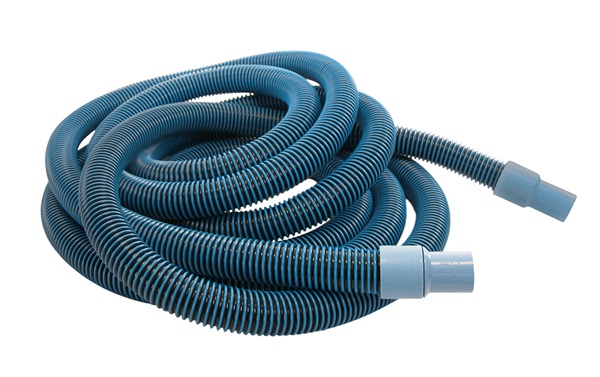
Identifying the perfect hose length and diameter for your swimming pool
- Hose Length: Measure the distance from your pool’s skimmer or vacuum port to the farthest point in the pool. Choose a vacuum hose that is long enough to reach this distance, with some extra length for flexibility and maneuverability.
- Hose Diameter: The most common diameter for pool vacuum hoses is 1.5 inches (38mm), although other sizes are available. Choose a hose diameter that matches the size of your pool’s vacuum port or skimmer basket for optimal suction and performance.
The importance of hose flexibility and durability
- Flexibility: Opt for a pool vacuum hose that is flexible and easy to maneuver around the pool without kinking or tangling. Flexible hoses can navigate corners, stairs, and obstacles more effectively, ensuring thorough cleaning of the entire pool surface.
- Durability: Look for a vacuum hose made from high-quality materials, such as durable PVC or reinforced polyethylene. A durable hose is less prone to punctures, leaks, and damage from exposure to chemicals, sunlight, and harsh weather conditions, ensuring long-lasting performance and reliability.
Comparing automatic pool cleaner hoses to manual pool vacuum hoses
- Automatic Pool Cleaner Hoses: Automatic pool cleaner hoses are typically designed for use with robotic or suction-side pool cleaners. These hoses are often made from flexible and durable materials and come in various lengths to accommodate different pool sizes. They feature swivel connectors or cuffs that prevent tangling and improve maneuverability.
- Manual Pool Vacuum Hoses: Manual pool vacuum hoses are used with traditional vacuum heads and require manual operation. These hoses are available in various lengths and diameters to suit different pool sizes and types. They are typically more affordable than automatic cleaner hoses but may require more effort to maneuver and maintain.
| Feature | Automatic Pool Cleaner Hoses | Manual pool vacuum hoses |
| Connectors | Specialized for specific cleaner models | Universal connections |
| Additional features | May have swivel cuffs and flow regulators. | Simpler design |
| Construction | Often sectional for flexibility | Single, continuous length |
| Material | High-quality PVC or reinforced plastic (similar to manual hoses) | High-quality PVC or reinforced plastic |
| Length | Chosen based on pool size (similar to manual hoses) | Chosen based on pool size (similar to automatic hoses) |
Maintaining Your Pool Vacuum Hose for Longevity
Maintaining your pool vacuum hose properly is essential for ensuring longevity and optimal performance. Here are some tips on proper storage to prevent damage, routine maintenance checks, and how to spot and repair leaks in your pool vacuum hose:

Tips on proper storage to prevent damage
- Coil the Hose Neatly: After each use, coil the pool vacuum hose neatly to prevent kinks, tangles, and twisting. Avoid bending the hose at sharp angles, as this can cause damage over time.
- Store Indoors: Store the vacuum hose indoors in a clean, dry area away from direct sunlight, extreme temperatures, and moisture. Exposure to UV rays and harsh weather conditions can degrade the hose material and shorten its lifespan.
- Use a Hose Reel or Storage Rack: Consider investing in a hose reel or storage rack specifically designed for pool vacuum hoses. These storage solutions help keep the hose organized, protected, and easily accessible for future use.
Routine maintenance checks for vacuum hoses
- Inspect for Wear and Tear: Regularly inspect the entire length of the vacuum hose for signs of wear, tear, or damage, such as cracks, splits, or punctures. Pay attention to areas near the hose ends and connectors, as these are common areas for wear.
- Check Connectors and Cuffs: Inspect the hose connectors, cuffs, and swivel fittings for any signs of leaks, corrosion, or damage. Ensure that the connections are secure and tight to prevent leaks during use.
- Clean the Hose: Periodically clean the vacuum hose inside and out to remove any dirt, debris, or algae buildup that may affect performance. Use a mild detergent or hose cleaner, and rinse thoroughly with clean water.
How to spot and repair leaks in your pool vacuum hose?
- Visual Inspection: To spot leaks in the vacuum hose, visually inspect the entire length of the hose while it is pressurized with water. Look for any signs of water dripping, spraying, or pooling along the hose.
- Submerge in Water: Another method to detect leaks is to submerge the vacuum hose in water while pressurized. Look for air bubbles escaping from the hose, indicating the location of the leak.
- Repairing Leaks: Once you’ve identified the location of the leak, mark it for repair. Depending on the severity and location of the leak, you can use repair tape, hose clamps, or patch kits specifically designed for pool vacuum hoses to seal the leak effectively. Follow the manufacturer’s instructions carefully for the best results.
Installing Your Pool Vacuum Hose with Ease
Installing your pool vacuum hose properly ensures a secure connection and optimal performance during pool cleaning. Here’s a step-by-step guide on attaching the hose to your pool cleaner, understanding the role of female cuff ends, and adjusting hose length for optimal pool coverage:
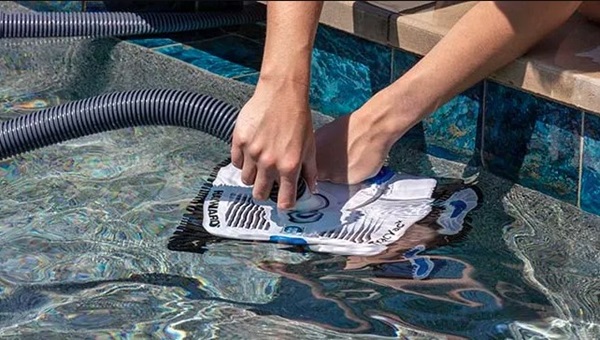
A step-by-step guide on attaching the hose to your pool cleaner
- Prepare the Vacuum Head: If using a manual pool vacuum, attach the vacuum head to one end of the vacuum hose. Ensure that the connection is secure and tight to prevent leaks.
- Connect the Hose to the Skimmer or Vacuum Port: If using an automatic pool cleaner, attach one end of the vacuum hose to the cleaner’s skimmer plate or vacuum port. Secure the connection by twisting the hose clockwise until it locks into place.
- Attach Hose Sections (if applicable): If using multiple sections of vacuum hose, connect the sections together using male and female cuff ends. Insert the male cuff end of one section into the female cuff end of the next section and twist clockwise to secure the connection.
The role of female cuff ends in secure hose connections
- Secure Connection: Female cuff ends play a crucial role in creating a secure and watertight connection between sections of vacuum hose. They feature grooves or ridges that grip the male cuff ends of adjoining hose sections, preventing leaks and ensuring smooth water flow.
- Preventing Tangling and Twisting: Female cuff ends often have swivel capabilities that allow the hose to rotate freely, preventing tangling and twisting during use. This ensures that the vacuum hose can move smoothly around the pool without getting stuck or tangled.
Adjusting hose length for optimal pool coverage
- Measure and cut (if necessary): Determine the appropriate length of vacuum hose needed to reach all areas of your pool from the skimmer or vacuum port. If the hose is too long, consider cutting it to the desired length using a sharp utility knife or hose cutter.
Leave Some Extra Length: Leave some extra length in the hose to allow for flexibility and maneuverability during cleaning. A slightly longer hose ensures that the vacuum can reach all areas of the pool without stretching or straining.
Test for Optimal Coverage: After attaching the vacuum hose to your pool cleaner, test the setup to ensure that it covers the entire pool surface effectively. Adjust the hose length or positioning as needed to achieve optimal coverage and cleaning performance.
By following these steps and guidelines, you can install your pool vacuum hose with ease and ensure a secure connection for efficient pool cleaning. Proper installation and adjustment of the hose length help maximize cleaning coverage and maintain optimal suction and performance, allowing you to enjoy a clean and well-maintained swimming pool all season long.
Enhancing Pool Cleaning Efficiency with the Right Hose Set
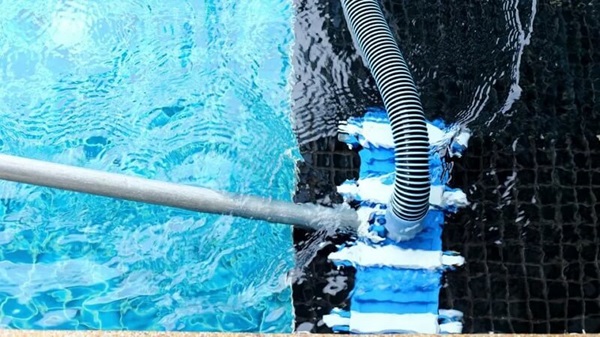
Benefits of upgrading to a professional 8 piece swimming pool vacuum cleaner hose set
Increased Versatility: Professional hose sets typically include multiple hose sections of varying lengths, allowing for greater flexibility and customization to suit different pool sizes and configurations.
Enhanced Durability: Professional-grade hoses are constructed from high-quality materials, such as reinforced PVC or polyethylene, which offer increased durability and resistance to damage from chemicals, UV rays, and harsh weather conditions.
Improved Suction Power: Upgrading to a professional hose set can improve suction power and efficiency by minimizing leaks, kinks, and restrictions in the hose system. This ensures optimal performance and thorough cleaning of the pool surfaces.
Convenient Storage and Organization: Many professional hose sets come with storage racks, reels, or bags for convenient storage and organization of the hose sections and accessories when not in use. This helps prolong the lifespan of the hoses and keeps them protected from damage.
How specific hose sets can improve suction and cleaning performance?
Optimized Length and Diameter: Professional hose sets are designed with optimized lengths and diameters to maximize suction power and water flow. This ensures efficient debris removal and thorough cleaning of pool surfaces, including floors, walls, and steps.
Swivel Cuff Ends: Many professional hose sets feature swivel cuff ends that allow for smooth rotation and movement of the hose without tangling or twisting. This enhances maneuverability and ensures uniform coverage during cleaning.
Leak-Resistant Design: Premium-quality hoses are constructed with leak-resistant materials and feature secure fittings and connectors to minimize water loss and maintain consistent suction throughout the cleaning process.
The compatibility of vacuum cleaner hoses with leading pool vacuum brands
- Many professional hose sets are designed to be compatible with a wide range of leading pool vacuum brands, including Hayward, Zodiac, Pentair, and Polaris, among others.
- Before purchasing a hose set, it’s essential to verify compatibility with your specific pool vacuum model to ensure proper fit and functionality.
- Some manufacturers offer universal hose sets that are compatible with most pool vacuum brands, providing versatility and convenience for pool owners with different vacuum models.
Troubleshooting Common Issues with Pool Vacuum Hoses
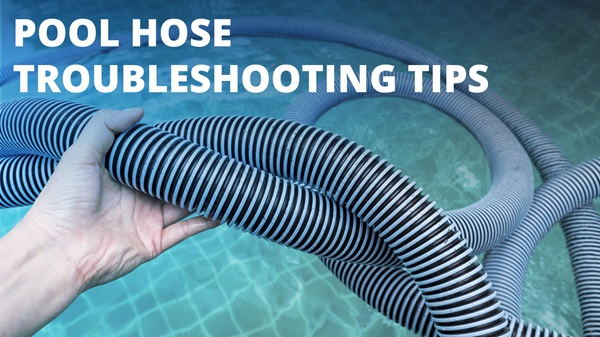
Dealing with loss of suction in pool vacuum hoses
Check for Blockages: Inspect the entire length of the vacuum hose for any obstructions, such as debris or leaves, that may be blocking the flow of water. Clear any blockages to restore proper suction.
Inspect Hose Connections: Check the connections between the vacuum hose sections, vacuum head, and skimmer or vacuum port for any leaks or loose fittings. Tighten connections as needed to prevent air leaks and maintain suction.
Clean or Replace Filter: A clogged or dirty filter can restrict water flow and reduce suction power. Clean or replace the filter according to the manufacturer’s recommendations to ensure optimal filtration and suction.
Understanding the impact of punctures or twists in your pool hose on cleaning efficiency
Punctures: Punctures in the pool vacuum hose can result in leaks and loss of suction, reducing cleaning efficiency. Inspect the hose carefully for any signs of punctures or tears, and repair or replace damaged sections as needed.
Twists: Twists or kinks in the vacuum hose can restrict water flow and reduce suction, affecting cleaning performance. Straighten out any twists or kinks in the hose, and ensure that it is properly coiled and stored to prevent future tangling.
Preventing automatic pool cleaner hoses from tangling
Use a Hose Swivel: Consider using a hose swivel or rotation device at the connection point between the hose and the cleaner to prevent tangling. Swivel fittings allow the hose to rotate freely as the cleaner moves around the pool, reducing the risk of tangling.
Proper Hose Length: Ensure that the hose length is appropriate for your pool size to minimize excess slack and potential tangling. Trim the hose if necessary to eliminate unnecessary length and reduce the risk of tangling.
Regular Maintenance: Perform regular maintenance checks on the automatic pool cleaner and hose to identify and address any issues that may contribute to tangling, such as worn-out or damaged parts.
By troubleshooting common issues such as loss of suction, punctures or twists, and tangling, you can ensure that your pool vacuum hose functions effectively and efficiently, keeping your pool clean and inviting for swimming. Regular maintenance and proper care help prolong the lifespan of the hose and ensure optimal cleaning performance throughout the swimming season.
Accessories and Add-ons for Your Pool Vacuum Hose
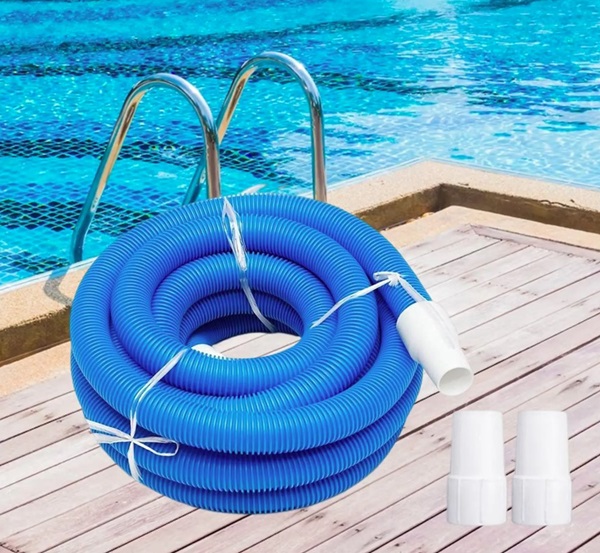
The significance of cuff ends and adapters for versatile cleaning
Cuff Ends: Cuff ends play a crucial role in ensuring a secure and watertight connection between vacuum hose sections or attachments. Female cuff ends feature grooves or ridges that grip the male cuff ends, preventing leaks and maintaining optimal suction.
Adapters: Adapters allow you to connect your pool vacuum hose to different types of pool equipment, such as skimmers, vacuum ports, or automatic pool cleaners. They provide versatility and compatibility, allowing you to use your vacuum hose with various pool cleaning devices.
Investing in durable hoses for in-ground versus above-ground pools
In-Ground Pools: In-ground pools typically require more robust and durable vacuum hoses due to their larger size, deeper depths, and rougher surfaces (e.g., concrete, plaster). Look for hoses made from reinforced PVC or polyethylene materials designed to withstand the rigors of in-ground pool cleaning.
Above-Ground Pools: Above-ground pools may benefit from lighter and more flexible vacuum hoses that are specifically designed for soft-sided pool surfaces (e.g., vinyl). These hoses should still be durable enough to handle regular use and exposure to pool chemicals and sunlight.
Exploring pool vacuum heads and other cleaner accessories for a deeper clean
Pool Vacuum Heads: Different types of pool vacuum heads are available to suit various pool surfaces and cleaning needs. Choose a vacuum head with brushes, wheels, or weights that are compatible with your pool’s surface material (e.g., concrete, vinyl, fiberglass) for optimal cleaning performance.
Brushes and Attachments: Additional brushes, scrubbers, and attachments can help enhance the cleaning effectiveness of your pool vacuum hose. Consider investing in specialized brushes for removing algae, stubborn stains, or debris from pool walls, steps, and corners.
Vacuum Skimmers and Nets: Attachable skimmers or nets can help trap larger debris before it enters the vacuum system, reducing the risk of clogs and prolonging the lifespan of your vacuum hose and filter.
In conclusion, the automatic pool vacuum hose is an indispensable component of a well-maintained pool. Its silent and efficient operation ensures a sparkling clean swimming environment, allowing pool owners to enjoy their leisure time without the hassle of manual cleaning.

Meet David Thomas, a seasoned professional with nearly 8 years of experience specializing in inspecting and resolving issues related to swimming pools. With his expertise and meticulous attention to detail, David ensures the safety and functionality of pools, making them a refreshing oasis for all to enjoy. Whether it’s troubleshooting equipment or maintaining water quality, David’s proficiency guarantees top-notch solutions tailored to meet every pool owner’s needs.
